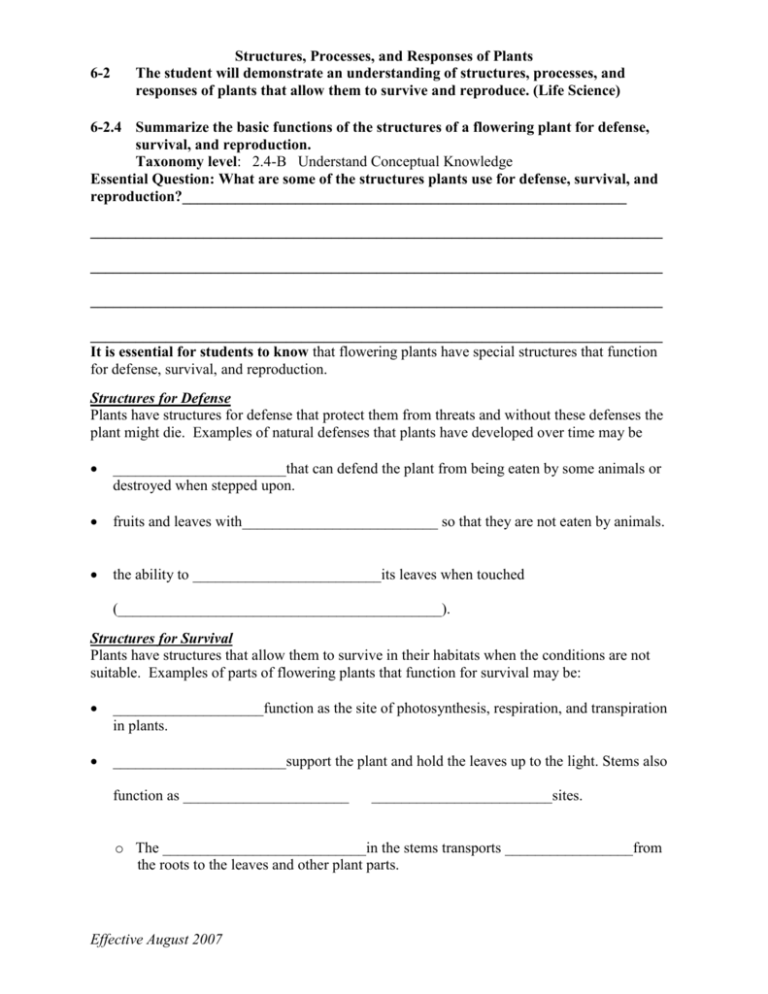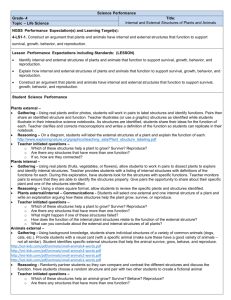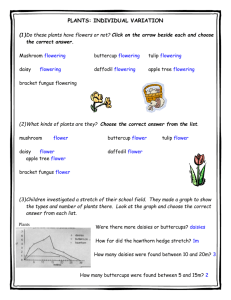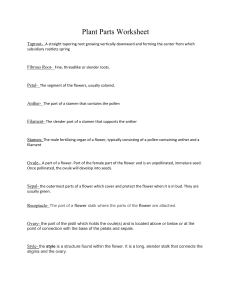Notes document for both presentations
advertisement

6-2 Structures, Processes, and Responses of Plants The student will demonstrate an understanding of structures, processes, and responses of plants that allow them to survive and reproduce. (Life Science) 6-2.4 Summarize the basic functions of the structures of a flowering plant for defense, survival, and reproduction. Taxonomy level: 2.4-B Understand Conceptual Knowledge Essential Question: What are some of the structures plants use for defense, survival, and reproduction?___________________________________________________________ ____________________________________________________________________________ ____________________________________________________________________________ ____________________________________________________________________________ ____________________________________________________________________________ It is essential for students to know that flowering plants have special structures that function for defense, survival, and reproduction. Structures for Defense Plants have structures for defense that protect them from threats and without these defenses the plant might die. Examples of natural defenses that plants have developed over time may be _______________________that can defend the plant from being eaten by some animals or destroyed when stepped upon. fruits and leaves with__________________________ so that they are not eaten by animals. the ability to _________________________its leaves when touched (___________________________________________). Structures for Survival Plants have structures that allow them to survive in their habitats when the conditions are not suitable. Examples of parts of flowering plants that function for survival may be: ____________________function as the site of photosynthesis, respiration, and transpiration in plants. _______________________support the plant and hold the leaves up to the light. Stems also function as ______________________ ________________________sites. o The ___________________________in the stems transports _________________from the roots to the leaves and other plant parts. Effective August 2007 6-2 Structures, Processes, and Responses of Plants The student will demonstrate an understanding of structures, processes, and responses of plants that allow them to survive and reproduce. (Life Science) o The _________________________in the stems transport ____________________made in the leaves to growing parts of the plant. _____________________help anchor the plant in the ground. o They also absorb __________________and ______________________ from the soil and store extra food for the plants. o The more __________________ ________________on the root that is available, the more water and nutrients it can absorb. o ____________________ ___________________________help to increase this surface area. There are __________________types of roots: fibrous roots and taproots. o _______________________ ________________________consist of several main roots that branch off to form a mass of roots. Examples are grass, corn, and some trees. Draw the fibrous root plant. o _____________________________consist of one large, main root with smaller roots branching off. Examples are carrots, dandelions, or cacti. Draw the taproot plant. _________________________have special structures that allow them to be dispersed by wind, water, or animals. The seeds ____________________helps _________________________ the embryo from injury and also from drying out. End of part one Effective August 2007 Structures, Processes, and Responses of Plants The student will demonstrate an understanding of structures, processes, and responses of plants that allow them to survive and reproduce. (Life Science) 6-2 Questions to complete for homework. 1. How do thorns protect a blackberry bush? 2. If some household and landscaping plants are poisonous, why do people continue to plant them? 3. If plant leaves are so important for survival, then how do plants that lose their leaves in the winter survive? 4. Why are stems important parts of a plant? 5. What systems in your body act like the stem of a plant? Define key terms. 1. thigmotropism 2. taproot 3. fibrous root Effective August 2007 6-2 Structures, Processes, and Responses of Plants The student will demonstrate an understanding of structures, processes, and responses of plants that allow them to survive and reproduce. (Life Science) Structures for Reproduction Parts of the flowering plant that function in reproduction include: Flowers Flowers produce ___________________________. Many flowers contain both _______________________and ____________________ parts needed to produce new flowers. Flower petals are often _____________________or have a _____________________ to attract insects and other animals. Stamen (the male flower part) The male part of a flower that has an ___________________________ on a stalk (filament). The _________________produces the ____________________ that contains the sperm cells. Draw and label the male parts of the flower. Pistil (the female flower part) The female part of the flower that contains o The __________________, which contains the ovules where the ___________cells are produced. o The __________________, which is the _____________top where pollen grains land. o The___________________, which is a stalk down which the pollen tube grows after pollination has taken place. Effective August 2007 6-2 Structures, Processes, and Responses of Plants The student will demonstrate an understanding of structures, processes, and responses of plants that allow them to survive and reproduce. (Life Science) Draw and label the female parts of the flower. Seed The ovule that contains the _____________________ __________ (embryo) from which new plants are formed. A ________________________that is formed from the ovary often protects them. Complete the essential question. Define key terms. 1. stamen 2. pistil 3. pollen 4. ovary 5. seed 6. anther Effective August 2007 6-2 Structures, Processes, and Responses of Plants The student will demonstrate an understanding of structures, processes, and responses of plants that allow them to survive and reproduce. (Life Science) 7. fruit 8. style 9. stigma Questions to complete for homework. 1. Identify the male reproductive parts of a flower. Include the overall name. 2. Identify the female reproductive parts of the flower. Include the overall name. 3. Why is it important that the stigma be sticky? 4. Once the pollen is on the stamen, what happens to it? Use your vocabulary. 5. What would attract another organism to a flower and why? Assessment Guidelines: The objective of this indicator is to summarize the basic functions of the structures of flowering plants; therefore, the primary focus of assessment should be to generalize points about the various structures needed for defense, survival, and reproduction. However, appropriate assessments should also require student to identify the parts of a flower used for reproduction; identify structures in plants used for defense, survival, or reproduction; illustrate a flower or plant structures using words, pictures, or diagrams; or classify a structure based on its function for defense, survival, or reproduction. Effective August 2007








